”The pressures of being prince aren’t easy in any royal family, and history is full of eccentric rulers, warped by a childhood spent under a golden thumb. But the stakes in the house of Osman were higher then in any other. Unlike other royal families which practiced primogeniture (the right of the first born son to rule) the Osman clan left things a bit more open ended. The Sultan often fathered anywhere from a dozen to over a hundred children during his rule, and upon his death, all were eligible for the throne. Truth is, for 9 out of a 10, being born to a Sultan was a death curse. Call it the sultans of swing(ing) from a noose made from a silk rope.
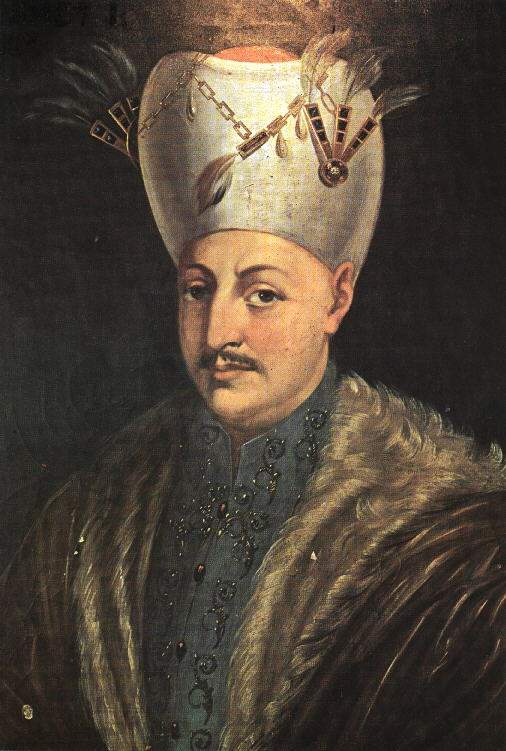
''So far the policy of brother killing was working out great. But it had one major drawback; it nearly wiped out the Osman family line. Once the Sultan had killed all his brothers it was up to him to carry on the Osman name, a risky business. (No doubt one of the reasons for the creation of Sultan Paste, known today as Turkish Viagra, an herbal aphrodisiac and energy booster. Perfect for the Sultan, tired after a long day of fratricide.)''
When the Sultan died a sort of deadly musical chairs for would-be Sultans began. Often, the son who was closest to the throne at the time of the Sultans death, literally the one nearest in physical distance from the throne, would become the new Sultan by jumping into the chair and declaring himself so. Upon ascending to the throne, the triumphant new Sultan would shout his first decree, usually something like “All my brothers are to be immediately killed.’ ” ( curiousexpeditions.org )
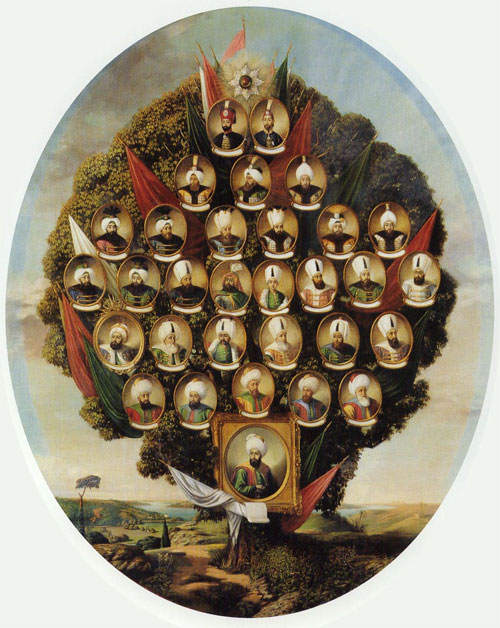
The Osman family. Sultans of the Ottoman. ''Ahmet was a kind ruler, and was very much in love with a young and beautiful greek girl named Maypeyker Kösem. Kösem, however, was more then just beautiful, she was cunning, brilliant and hungry for power. Sultan Ahmet I left another legacy besides the Blue Mosque. Ahmet was the first Sultan to break with the practice of royal fratricide. Ahmet had grown up with a slightly retarded brother named Mustafa. Ahmet was well known for his compassion, and when it came time to have his mildly retarded brother Mustafa done in, he just couldn’t do it.''
The court artists given the task to depict the sultans of the Ottoman empire, such august and all-powerful personages had a difficult task. One was that the subject may not be alive long enough to see the finished work. Being the sultan had its privileges but murder and assassination were greater threats than the heathens and heretics in distant lands. Ascension to the bejeweled imperial throne was almost the kiss of death; death row inmates in Texas at least have recourse to an appeals process unlike the swinging sultans.
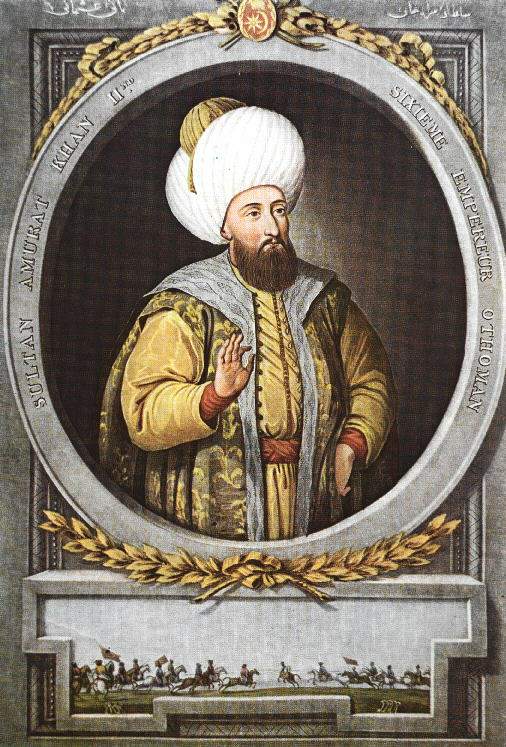
''After a few months the confused Sultan was sent on a hunting trip only to come back and find he had been deposed by his nephew Osman II and Mustafa was sent back to the golden cage. (This was the first deposing in Ottoman history.) The young Osman II was then himself deposed and killed. Mustafa was dragged back out of the golden cage, re-enthroned, only to be deposed again by his other nephew Murad IV. Mustafa was finally sent happily back to his safe Golden Cage where he could read in peace…before eventually being strangled by the silk rope.''
”An army of deadly eunuchs would then be sent forth to do just that. All brothers, including infant children, and mothers carrying as of yet unborn brothers were quickly eliminated. These eunuch assassins were curious in that, in addition to having been castrated, they had also had their eardrums poked out, so as not to hear the screams of their victims, and their tongues split, so that they could not speak of their dastardly deeds. The preferred method for royal fratricide was strangulation by silk rope…a classy way to go at least. Royal fratricide was the standard and regarded as simply part of the bargain. Sultan Mehmed III had some nineteen of his pre-teen brothers killed, and seven concubines pregnant with possible nephews stuffed in sacks and thrown into the Bosporus.”
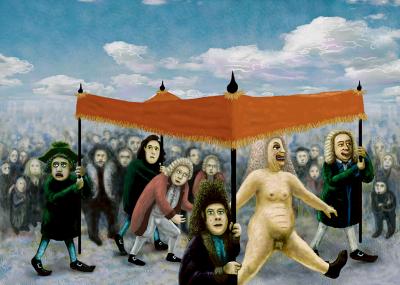
Thorarinn Leifsson. The Emperor's New Clothes from Hans Christian Anderson. The Sultan's provided the template.
The painters, like almost everyone else lived in fear of their hide. The sultan had to be portrayed as bigger than the people around him and his rich robes had to billow out to fill an inordinately large share of the picture space. In the harem, the emperor wore no clothes ,but not in portraits. Painters and artists were basically slaves; roughly on the same level as the floor sweepers and the servant who carried in the clock when the sultan inquired about the time of day; though slightly less status than than the man who bore an extra royal turban in public processions and bobbed it up and down to save the sultan the effort of acknowledging the applause of his subjects.
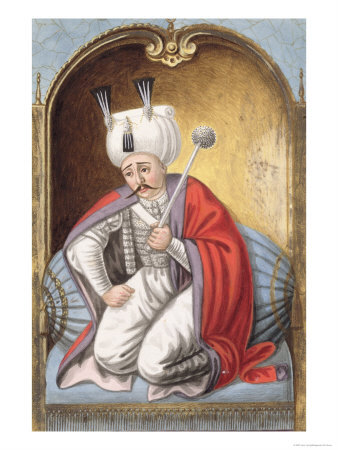
Sultan Selim the Grim. ''Sultan Selim the Grim had a couple brothers, a handful of nephews, and some five dozen other relatives offed. Earning his nickname “Grim” he even killed four out of his five sons so his favorite son Suleiman, would be sure to inherit the throne. (Suleiman went on to be a the great Sultan Suleiman the Magnificent.)''
A number of the painters came from Persia, for the Turks then thought of that country as the home of art, much as Americans at one time considered France. Persian miniatures, which earlier had been influenced by the art of Turkish central Asia, now influenced Ottoman art. Yet, there were differences, many of them traceable to old Turkish traditions, inherited from the art of tribal days. The costumes depicted, the shape of mountains in landscape paintings, the postures of the sitters, who were usually shown seated with legs crossed
most in the pose of Buddha; recalled the art of central Asia rather than that of Persia.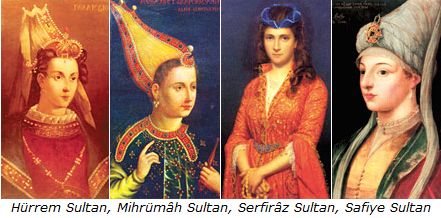
''Kösem took the opportunity presented by the death of Osman II. Her oldest son Murad IV was only 11, still a minor, so when he took the throne, the seductive Kösem became official regent of the Ottoman empire. It is a notable peculiarity that the Turkish and Muslim empire was officially ruled by Kosem, a Greek woman, for over 9 years, and unofficially by her for another 20. Kösem was perhaps the most significant part of 130 Ottoman period known as the Sultanate of women, in which the ladies, the wives and mothers of the Sultans, held considerable power.''
The Persians used a wide range of delicate colors. The Turks employed fewer colors, but they were generally bolder. The Persians painted amorous scenes and gardens, or depicted the legendary exploits of ancient heroes. The Turks, more realistic, painted cities and soldiers, tradesmen and public festivals. Persian influence on Turkish art was supplemented by Western influence. In the year 1479, Mohammed II asked the Venetian senate to send him a qualified portrait painter. The Venetians exported Gentile Bellini , who provided the sultan with a number of portraits and with erotic pictures as well.
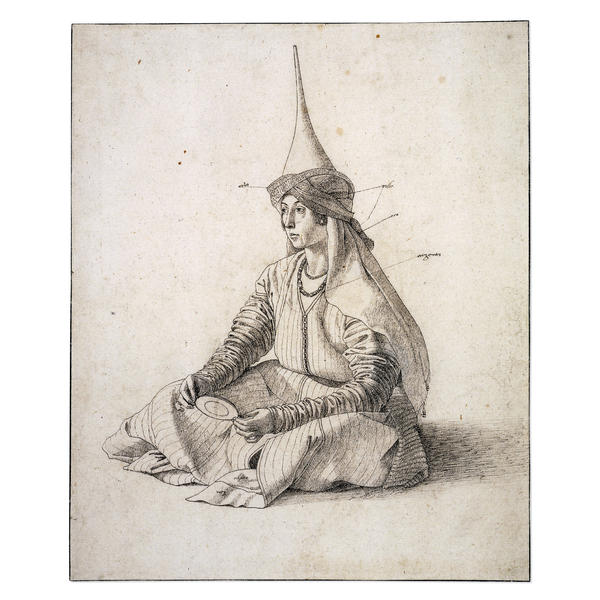
livingpast.com Turkish woman . ''Drawing by Gentile Bellini, late 15th Century. Image captured from the British Museum web site.''
Bellini soon left, terrified, as one story has it, when the sultan, who was dissatisfied with his picture of John the Baptist, decapitated a slave in his presence to show him what a severed head really looked like. But even after Bellini’s departure from the Ottoman court, Western influences remained.
Evidently, the sultans maintained high aesthetic standards. Indeed, their standards were so high that they required foreign ambassadors to dress in robes of silver or gold brocade, supplied from the palace storerooms, before they were welcomed into the royal presence. But it was not aesthetic considerations alone that informed the royal art collection. Greed was also an important factor, for the Ottoman rulers acquired art the same way they did provinces or women for the harem. They were particularly eager to possess ingenious and beautiful machines. Queen Elizabeth I of England sent Murad III a mechanical organ. He loved it.
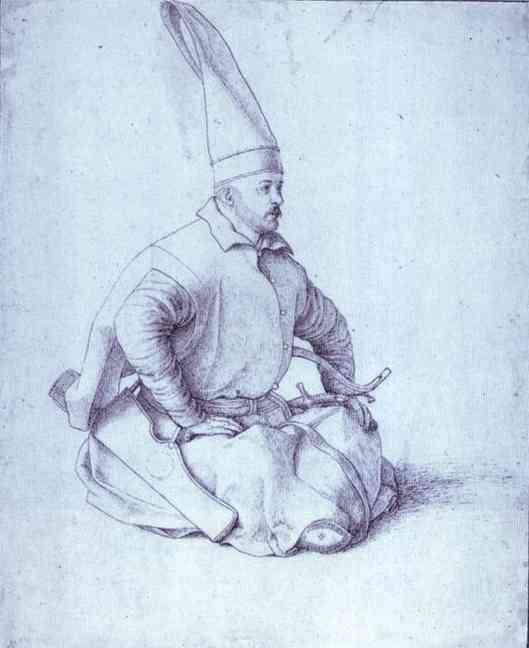
Gentile Bellini. ''Drawing by Gentile Bellini, late 15th Century. Image captured from the British Museum web site. Technicaly, Jannissaries like the man pictured here weren't "Turkish" in the modern ethnic sense; they were originally children of rural, Christian families who were forcibly taken to be converted to Islam and raised in the sultan's palace.''
During the sixteenth and seventeenth centuries the sultans were the most powerful potentates in the world, and the custom that rulers have always had , and still have, of sending gifts to each other rewarded them considerably. The English sent gilt plate and beautiful clocks, the French parcels of Lyon silk. From Russia came bales of fur. Aside from gifts there was booty. When the Turks conquered Cairo in 1517, and on several occasions when they invaded the Persian capital of Tabriz, they seized immense quantities of Chinese porcelain, whose influence is evident in the fine Turkish ceramics that were made in the sixteenth and seventeenth centuries.

''All the procedures within the palace were codified in kanunname, or law codes that even specified the dress for every rank of the ruling class. Pictured here is the Sultan leaving Topkapi Palace for Friday prayers in one of the capital's mosques circa 1810 by an unknown artist. The once-a-week outing was the only time the Sultan appeared in public. The advisers to the Sultan, the viziers, wore green. Chamberlains wore scarlet. Religious dignitaries wore purple and mullahs light blue. The master of horse dressed head-to-foot in dark green.''
Much of the Chinese ware is, perhaps understandably, of the variety known as celadon, which was supposed to detect poisoned food by making it bubble and seethe. In 1922, after the last sultan was overthrown, a great store of porcelain was discovered in the palace, still packed in the cases in which it had come centuries before.
After the eighteenth century Ottoman power declined. The boundaries of the empire receded, and native art traditions decayed and all but disappeared, since artists now preferred to imitate Western work. The Grand Seraglio in Constantinople sank into decrepitude, as the sultan moved his home and his harem to palaces built in debased Western style. The sultan’s great firework displays, with their dragons, castles, giants, and representations of Noah’s ark, and the stately processions of soldiers and dignitaries in robes of satin and velvet and cloth of gold, can now be seen only in the miniatures which depict royal ceremonies and public festivals.
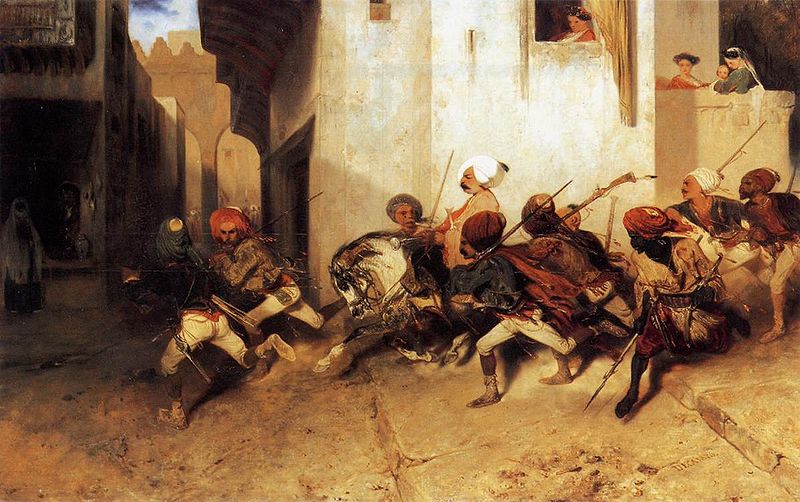
billkralovic.com A French Artist Portraying a Janissary Patrol in Izmir, Turkey...''The janissaries were a sign that the Ottoman Empire was in decline. They originally were an elite guard for the Sultan, but eventually turned into autonomous dictators, and in Serbia, they basically made the Serbs, serfs of the themselves as feudal overlords. This was in direct opposition to the some wealthy Serb pig merchants, who had a rich trade with the Austro-Hungarians in Vojvodina.''key (1831)
”The excessive interference of harem women was a main factor in the eventual decline of the Ottoman Empire. The increase in harem size was correlated to the increase in expenditures incurred partly by the larger number of women and partly by the extravagances of various Sultans. The intrusion of women into the Ottoman governing structure caused fundamental changes in state policies towards the roles of the Princes by limiting the Prince’s governing and public duties. The abandonment of the one mother-one son reproductive policy combined with the change in law regarding the Kafes meant that many of the Sultans of the seventeenth century lacked experience in government and looked towards their mothers, the Valide Sultan, for guidance and advice. This, in turn, meant that the Valide Sultan and the Sultan’s favorites were able to influence the actions and decisions of the Sultan.” ( www.allaboutturkey.com )…The rule of Ibrahim the Mad, Kösem and the period surrounding it, marked a turning point in the Ottoman empire, and the beginning of its decline. The Sultans that ruled were often ill prepared having spent their whole life in the golden cage. In addition, the intrigues between the jannisaries, the eunuchs, the grand viziers, the Sultans mother and his many wives, all added to the downfall of the empire.
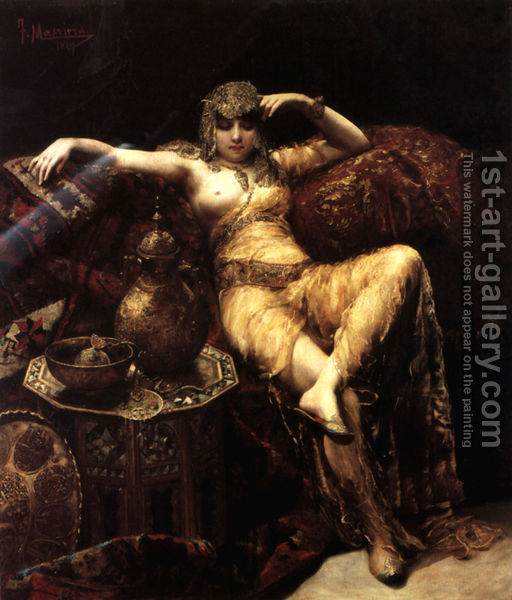
'' A Harem Beauty by Francisco Masriera y Manovens Odalisques were at the bottom of the harem hierarchy. They were considered to be general servants in the harem. They were not usually seen to be beautiful enough to become presented to the Sultan. Odalisques that were seen as potential candidates for concubinage were trained to become talented entertainers. The greatest honor a Sultan could bestow upon a male guest was to present him with an odalisque from his court who had not yet become his concubine. These women were greatly coveted as they were beautiful and talented, and what is more important, had links into the harem hierarchy. ''
”Ibrahim also lived under the constant and reasonable fear of deaf-mute eunuchs throttling him with a silk rope. So it makes sense that when guards showed up to bring him to the throne, he refused to go, thinking it was a trick. Ibrahim wouldn’t even open the door until Murad’s body was produced, and his mother Kösem had to “coax him out as if cajoling a kitten with food”. When Ibrahim was finally convinced that he was not about to be garroted to death, he ran deliriously through the halls screaming “the butcher is dead”, “the butcher of the empire is dead.”
Suddenly out of the cage and the supreme ruler of an enormous empire, Ibrahim barely knew what to do with himself. While his mom did most of the actual decision making, Ibrahim busied himself with his new harem. He first decorated his room with mirrors so that he might get a better view of himself in action. He then called the girls in. Dimitri Cantemir wrote in his History of the Growth and Decay of the Ottoman Empire,“In the palace gardens he frequently assembled all the virgins, made them strip themselves naked, and neighing like a stallion ran amongst them and as it were ravished one or the other, kicking or struggling by his order.”
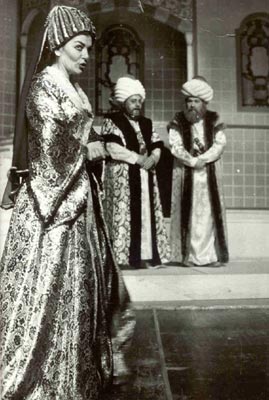
''For a woman who ruled the empire for well over 30 years Kösem met with a very ignoble fate. According to the “theottomans.org” when confronted by the eunuchs sent to kill her “she went mad, stuffıng her precious jewels into her pockets and fleeing through the intricate mazes of the harem, which she knew better than anyone. She crept into a small cabinet, hoping that the eunuchs would go past her and the janissaries come to the rescue. But a piece of her skirt caught in the door, betraying her hiding place. The eunuchs dragged her out, tearing her clothes, stealing her jewels. She fought; but she was an old woman now. One of her attackers strangled her with a curtain. Her naked, bleeding body was dragged outside and flaunted before the janissaries.”
”Ibrahim’s harem was full of young, nubile, girls from around the world. But after a while, the slender things from Russia and the Balkans didn’t do it for him anymore. One day Ibrahim happened to see the genitalia of a female cow. Pleased by what he saw, Ibrahim had a gold cast made and, hoping to find a human match to the bovine privates, he ordered his aides to “bring him the fattest woman in the world.” They did their best, finding a 300 pound Armenian girl named “Sugar Cube” (Sechir Para or more literally translated “Sweet Lump of Sugar”).
Ibrahim loved her, and spent many a night curled in her large arms. It wasn’t long until the big woman had gained power over Ibrahim equal only to that of her girth. It would be Sugar Cube who would spell the final downfall of Ibrahim the Mad.

Ingres. The Turkish Bath.''I’ve always meant to do something with it because a) I really love Ingres, b) the image is just so iconic and c) that back is just a blank canvas screaming for a tattoo. At least that’s what I see when I look at it. So for years I’ve toyed with various ideas (for a while I was this close to painting her as the Bride, replacing the turban with that big shock of hair and a big Frankenstein’s monster tattoo on her back). ''
Sugar Cube told Ibrahim that a member of his concubine was sleeping with an outsider and conspiring against him. The paranoid Ibrahim, decided to clean house and had the majority of his harem, some 280 girls, tied up in sacks and drowned in the river. (Though this may be an apocryphal story, it is easy to believe that the unstable Ibrahim might have had at least a number of his own harem killed.) This worried his mother Kösem, who was actually ruling the foundering empire. Concerned about Sugar Cube’s rising power, she in turn had Sugar Cube strangled. The palace was indeed a rough place.”





 COMMENTS
COMMENTS
Is it Ingres who painted a work depicting a sultan having his harem slain before his eyes?
I enjoyed this site.
Thanks
I am Turkish. I’m proud of my ancestors